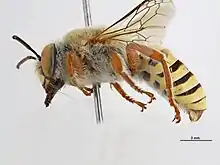Stenotritidae
The Stenotritidae is the smallest of all formally recognised bee families, with only 21 species in two genera, all of them restricted to Australia. Historically, they were generally considered to belong in the family Colletidae, but the stenotritids are presently considered their sister taxon, and deserving of family status.[1] Of prime importance is that the stenotritids have unmodified mouthparts, whereas colletids are separated from all other bees by having bilobed glossae.
| Stenotritidae | |
|---|---|
 | |
| Ctenocolletes tigris | |
| Scientific classification | |
| Domain: | Eukaryota |
| Kingdom: | Animalia |
| Phylum: | Arthropoda |
| Class: | Insecta |
| Order: | Hymenoptera |
| Clade: | Anthophila |
| Family: | Stenotritidae |
| Genera | |
|
Ctenocolletes | |
The American entomologist Ronald J. McGinley proposed their position as an independent family based on the morphology of the glossae in 1980. [2] This view quickly became established.
They are large, densely hairy, fast-flying bees, which make simple burrows in the ground and firm, ovoid provision masses in cells lined with a waterproof secretion. The nests of some species can reach a depth of more than three metres.[3] The larvae do not spin cocoons.
Fossil brood cells of a stenotritid bee have been found in the Pleistocene of the Eyre Peninsula, South Australia.[4]
Species
The family contains two genera: Ctenocolletes and Stenotritus.
Ctenocolletes
- Ctenocolletes albomarginatus (Michener, 1965)
- Ctenocolletes centralis (Houston, 1983)
- Ctenocolletes fulvescens (Houston, 1983)
- Ctenocolletes nicholsoni (Cockerell, 1929)
- Ctenocolletes nigricans (Houston, 1985)
- Ctenocolletes ordensis (Michener, 1965)
- Ctenocolletes rufescens (Houston, 1983)
- Ctenocolletes smaragdinus (Smith, 1868)
- Ctenocolletes tigris (Houston, 1983)
- Ctenocolletes tricolor (Houston, 1983)
Stenotritus
- Stenotritus elegans (Smith, 1853)
- Stenotritus elegantior (Cockerell, 1921)
- Stenotritus ferricornis (Cockerell, 1916)
- Stenotritus greavesi (Rayment, 1930)
- Stenotritus murrayensis (Rayment, 1935)
- Stenotritus nigrescens (Friese, 1924)
- Stenotritus nitidus (Smith, 1879)
- Stenotritus pubescens (Smith, 1868)
- Stenotritus rufocollaris (Cockerell, 1921)
- Stenotritus splendidus (Rayment, 1930)
- Stenotritus victoriae (Cockerell, 1906)
References
- Danforth, Bryan N.; Sipes, Sedonia; Fang, Jennifer; Brady, Sean G. (2006). "The history of early bee diversification based on five genes plus morphology". Proceedings of the National Academy of Sciences of the United States of America. 103 (41): 15118–15123. Bibcode:2006PNAS..10315118D. doi:10.1073/pnas.0604033103. ISSN 0027-8424. PMC 1586180. PMID 17015826.
{{cite journal}}: CS1 maint: date and year (link) ResearchGate Publication 6778915 - McGinley, Ronald J. (1980) [1980]. "Glossal Morphology of the Colletidae and Recognition of the Stenotritidae at the Family Level (Hymenoptera: Apoidea)". Journal of the Kansas Entomological Society. Kansas (Central States) Entomological Society. 53 (3): 539–552. eISSN 1937-2353. ISSN 0022-8567. JSTOR 25084069.
{{cite journal}}: CS1 maint: date and year (link) - Houston, Terry F. (1987-04-13). "A second contribution to the biology of Ctenocolletes bees (Hymenoptera: Apoidea: Stenotritidae)" (PDF). Records of the Western Australian Museum. 13 (2): 189–201. ISSN 0312-3162. S2CID 54842580.
{{cite journal}}: CS1 maint: date and year (link) BioStor BHL ResearchGate Publication 267823176 - Houston, Terry F. (1987-05-29). "Fossil brood cells of stenotritid bees (Hymenoptera: Apoidea) from the Pleistocene of South Australia". Transactions of the Royal Society of South Australia. 111 (1–2): 93–97. ISSN 0372-1426. S2CID 86005131.
{{cite journal}}: CS1 maint: date and year (link) BioStor BHL
- Michener, Charles D. (2000). The Bees of the World. Vol. 1 (1st ed.). Baltimore, Md.: Johns Hopkins University Press. pp. 1–930. ISBN 978-0801861338.
{{cite book}}: CS1 maint: date and year (link)